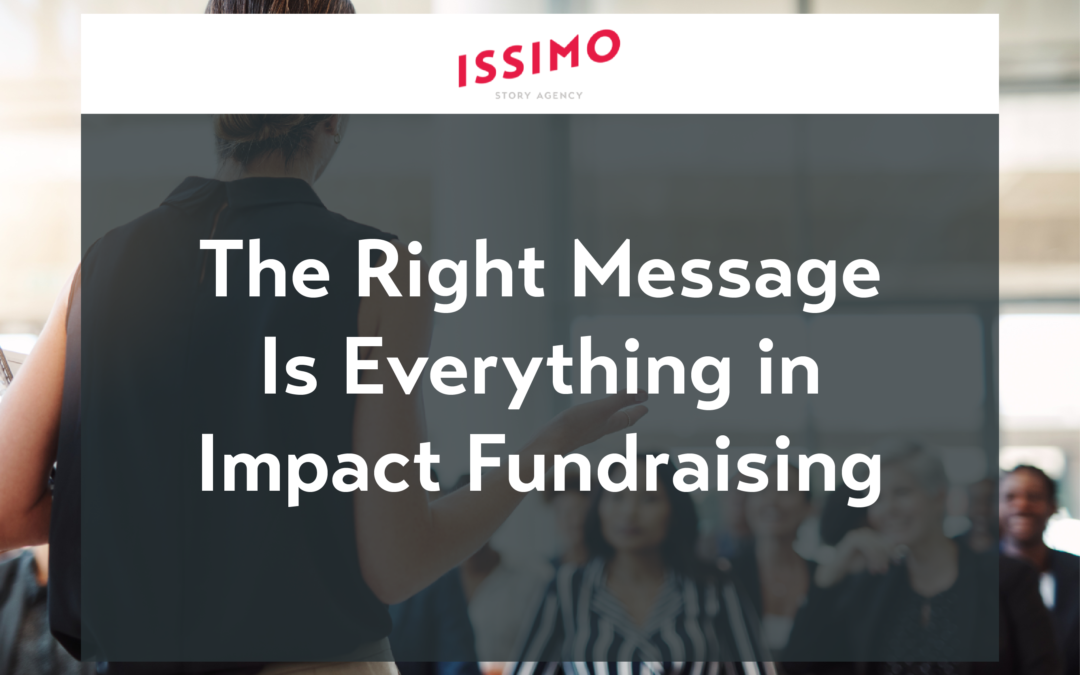Elements of Successful Impact Fundraising Messaging
We recently conducted an attitudinal research study across 34 countries and 159 organizations to learn more about the state of impact fundraising. The results were eye-opening and thought provoking. Case in point: When asked what the most effective element is in their fundraising efforts, 72 percent of respondents say it’s the impact they make and results from their work.
Results sell because they’re grounded in numbers — whether it’s evidence from past performance or if there’s a new venture, trust that the organization has the right approach to generate results in the form of financial returns or impact.
Additionally, respondents cited strong visual storytelling (71 percent) and a strong brand story (68 percent) as being effective. Although they’re less tangible than metrics, they’re still very important for successful fundraising. These two elements ranked higher than a strong financial record, strong fundraising track records, charismatic leader/founder, and having an affiliation with celebrities.
The common thread here is that impact fundraisers find more success when elements speak to the head (i.e., logic, numbers, results) and the heart (i.e., emotion, visual storytelling and brand story). But you actually need both to make the biggest impact.
In today’s post, we’ll dive into the elements of impact fundraising messaging and successful storytelling.
Emotion Is a Key Element of Impact Fundraising Messaging
A common complaint we hear about impact fundraising is that stakeholders (investors, donors and partners) only care about results and numbers. That’s because for decades, the prevailing paradigm of decision-making has centered exclusively on cognition. But new research in behavior science, neuroscience and psychology is unveiling the important part that emotion also plays.
“Indeed, many psychological scientists now assume that emotions are, for better or worse, the dominant driver of most meaningful decisions in life…even when they do so without awareness.” — Emotions and Decision Making, Annual Review of Psychology, 2015
“We love to believe we are rational, thinking people who, on occasion, feel some emotion. However, everything we know about who we are as people neurobiologically points to one thing and that is we are emotional, feeling beings who on occasion think.” — Brené Brown, 2016
Compelling impact fundraising messaging combines the logical neocortex brain with justification and engages the emotions of the limbic brain to unlock behavior.
A good example of this is Zurich’s responsAbility Investments AG, an impact asset manager with 3.7B dollars AUM of investments in 72 countries. Their communications team wanted to augment their investing reporting with stories and films to make more of an emotional connection to potential and existing investors.
The key takeaway is that you shouldn’t throw out financial reporting, charts and spreadsheets. Instead, combine those with elements that evoke emotion. Without emotion, your audience may understand and agree with you, but they won’t feel compelled to take action (like donating to your organization).
Evoke Emotion Through Visual Storytelling
One way for impact fundraising messaging to be successful is by evoking emotion through visual storytelling. Every time you pitch an investor, it’s like a job interview. Many times you’ll greet someone who is skeptical, disinterested or distracted because they are bombarded with so many other options and pitches.
The visual way you communicate your offering is sometimes the first thing they experience — way before your business model or rate of impact and returns. Don’t give them an excuse to discount you because of how your ideas are visually communicated.
What your ideas wear to the interview communicates the value of the ideas inside. Make sure they match what you want them to think and feel. Don’t give investors and donors any reason to discount the value you can provide.
Evoke Engagement Through Brand Stories
According to a Stanford University study, stories are 22 times more memorable than facts alone.
“The shortest distance between two people is a story.” — Patti Digh
A compelling story is essential for successful impact fundraising messaging, and it includes three elements:
- What does your audience want, and what’s in the way of them getting it?
- What unique value does your organization offer?
- How can you help your audience get what they want?
Experience vs. Efficacy
Our research revealed that 70 percent of respondents say their organization has at least some experience fundraising. But we found a substantial gap between experience and efficacy.
44 percent of respondents say their organization is only somewhat effective at fundraising, and only 30 percent of respondents say their organizations are very or extremely effective at fundraising. That means for two-thirds of participants, there’s room for improvement.
We asked respondents to choose two characteristics they feel would have the most significant impact on the success of their organization’s fundraising efforts. Here are the key insights:
- 65 percent say a clear and compelling message that connects with investors would significantly impact their organization’s fundraising.
- 58 percent say ample resources to get the message out, including time, budget, and talent, would have the greatest impact.
- 23 percent say ideal media or analyst coverage would make a difference for their organizations.
- 21 percent say a history of strong financial performance makes a difference.
Our goal of this research study is to learn impact fundraising best practices and share them broadly so more organizations can benefit from more capital flows. For those who want to drive action (i.e, raise funds for your impact organization), you need to lead with speaking to the head and the heart through impactful storytelling and brand stories. Research shows that how you craft your story determines how much the audience connects with it — and whether they want to hear more.
To learn more about each segments’ behaviors and the opportunities they present, check out our entire executive summary. And to explore the data yourself, check it out here.

